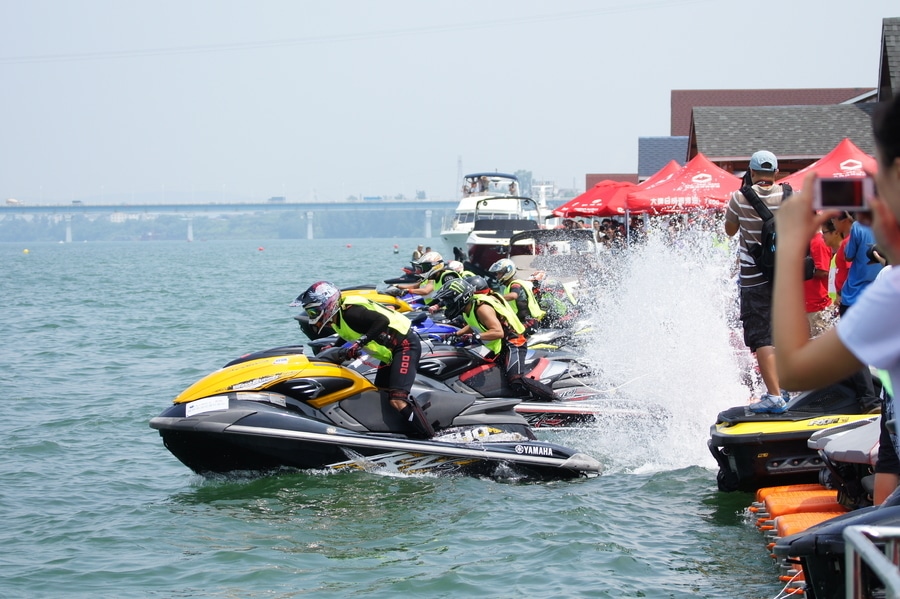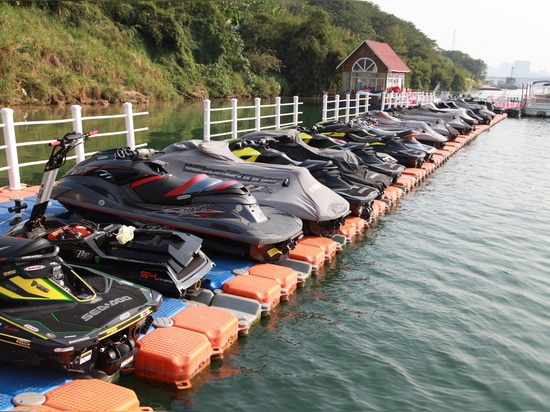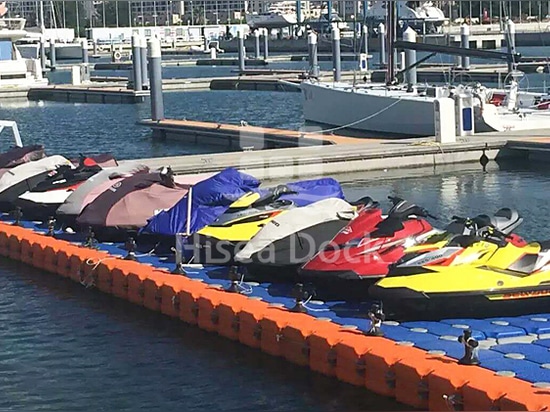
#Industry News
Jet Ski Weight Explained: How Much Does a Jet Ski Weigh?
How Much Does a Jet Ski Weigh?
Understanding Dry Weight vs. Wet Weight
In personal watercraft specifications sheets, two main figures are used to measure mass: dry weight and wet weight. To make proper calculations and decision-making, there must be a definite difference between these two metrics.
Dry Weight is where the personal watercraft is as it leaves the factory. This number involves the hull, engine, seat, handlebars, and all other standard parts that make up the structure and functioning of the machine. It, however, strictly excludes all fluids required to operate. This implies that the fuel tank is dry, the engine oil tank is empty, and the coolant and the battery are not part of this measure. The dry weight figure is a standardized number that manufacturers use to ship and compare the baseline; however, it is not the weight of the PWC when it is ready to go.
The more useful figure to owners is Wet Weight, also called Curb Weight. It is the total weight of the PWC, including all the fluids required and a standard set of equipment. This consists of a full tank of fuel, engine oil, coolant, and the battery. The most accurate way to show what the PWC will weigh when you are maneuvering it onto a trailer or getting it ready to launch is by the wet weight. Curb weight should be the initial figure of reference for any calculations that concern towing, launching, and storage in a floating platform. Dry weight, compared to wet weight, can be a significant difference with an addition of 100 to 150 pounds (45 to 68 kg) or even more, depending on the fuel capacity and engine size of the PWC.
Average Jet Ski Weight by Type
Personal watercrafts are divided into a number of different categories that are specialised to meet the needs and preferences of various riders and applications. This is a direct reflection of the weight of vehicles, which differs greatly depending on the type.
Don’t Forget Trailer and Gear Weight
The curb weight of the PWC is just part of the overall weight you will be handling. You should consider the trailer and all the gear to get the real load. This overall weight can be known as the Gross Trailer Weight (GTW).
PWC Trailer
Trailer Weight: PWC trailers are not very heavy, yet their weight cannot be ignored. The weight of a single-place trailer is usually between 200-400 pounds (91-182 kg). A double trailer, which will accommodate two PWCs, may weigh between 400 and more than 600 pounds (182 and 272 kg). The weight specification of the trailer is normally indicated on a placard on the frame of the trailer.
Fuel Weight: Gasoline weighs about 6.3 pounds per gallon. An 18-gallon fuel tank will have approximately 113 pounds of extra weight when it is filled. This is usually the greatest single component of the difference between dry and wet weight.
Gear and Accessories: Safety (fire extinguisher, anchor, dock lines), personnel (coolers, towels, dry bags), and aftermarket (sound systems, fishing racks) add to the total weight. Although not a lot on its own, all this equipment can add another 20 to 50 pounds (9 to 23 kg) to the total weight.
To have a better idea of what your vehicle will be towing, it is best to have an estimate that is on the conservative side and encompasses everything. One can do this simply by:
Total Towing Weight = Wet Weight of the PWC + Trailer Weight + Gear and Fuel Weight
Getting this calculation correct is not merely a matter of numbers, but allows you to be within safe towing limits, and prevents undue wear and tear on your trailer, vehicle, and braking system.
Matching Jet Ski Weight to Your Vehicle
The most important safety check any owner can do is to make sure their watercraft and trailer do not weigh more than their vehicle is rated to tow. The vehicle manufacturer specifies this non-negotiable limit and can be located in your owner’s manual, on the information sticker inside the driver’s side door jamb, or can be found online by searching for the VIN of your vehicle. You need to know this number before you tow and compare it to the total weight you are planning to tow, which is called the Gross Towing Weight (GTW).
Your GTW is a simple calculation that involves adding three important components. As a practical example, let us take one of the most popular models, the Yamaha FX Cruiser HO:
PWC Wet Weight: The dry weight of the craft (807 lbs) + weight of fuel and fluids. The complete 18.5-gallon tank will weigh about 110 lbs, taking the wet weight of the PWC to about 917 lbs.
Trailer Weight: Add your trailer weight. An average, single-place trailer is approximately 300 lbs.
Gear Weight: Lastly, include the weight of all your gear, coolers, safety equipment, and accessories, which can easily amount to 50 lbs or more.
The calculation that is arrived at is: 917 lbs (PWC) + 300 lbs (Trailer) + 50 lbs (Gear) = 1,267 lbs (GTW)
Your vehicle has a calculated GTW of 1,267 lbs; your vehicle should have a higher towing capacity than this value. To be safe, you must have a buffer; you must never use your GTW, which is more than 85-90 percent of your vehicle’s maximum. In the above case, a 1,500 lb capacity vehicle would do. Failure to observe these limits is incredibly hazardous and may result in a disastrous brake failure, uncontrolled sway of the trailer, and a permanently damaged engine, transmission, and frame of your vehicle, as well as almost certainly invalidate your warranty and insurance policy.
Easy Launching & Docking For Any Weight
jet-ski-docked-on-the-floating-dock
A personal watercraft’s weight presents its greatest challenge on the shoreline. The physical effort of maneuvering a heavy machine on a trailer, combined with the risk of scratching the hull against a traditional fixed dock, can detract from the overall ownership experience. Leaving the craft in the water also exposes it to marine growth and potential moisture issues.
To address this, modern drive-on floating docks have become the preferred solution. These systems allow a rider to use the PWC’s momentum to gently glide up a sloped platform, lifting the entire craft securely out of the water. This innovation effectively neutralizes the challenges of weight, transforming launching and retrieval into a simple, one-person operation.
As specialists in this technology, we at Hisea Dock have perfected this concept. Our drive-on jet ski docks, crafted from highly durable, UV-resistant HDPE, provide a stable and non-slip surface that protects your PWC’s hull. This approach not only prevents damage and keeps the craft dry for easy maintenance but also ensures your investment is secure. With over a decade of global experience and a 5-year warranty, our systems offer a reliable, long-term solution tailored to any waterfront.
Explore our floating jet ski docks today and discover how to make your time on the water truly effortless.
How Weight Impacts Performance and Handling
A PWC mass is an essential parameter in its dynamic behaviour on the water. The physics of weight explains the effects that weight has on every part of performance.
Acceleration
A lighter PWC will have a faster acceleration with the same horsepower. The less mass, the less inertia and, therefore, the faster the engine can get it moving. This is the reason Rec-Lite and Performance versions are more sensitive to throttle control, whereas heavier Luxury versions are slower reaching the line.
Top Speed
The primary consideration of the maximum speed is engine power, but an additional weight will increase drag. A heavier boat will be below the waterline, moving more volume and generating more hydrodynamic drag. This may cost it a little at top-end speed against a lighter car with an identical engine.
Fuel Efficiency
A heavier PWC will need greater engine thrust to achieve the same speed, directly increasing fuel consumption. The lighter models tend to be more economical, and as such, they are more appropriate when doing long-distance cruising or day-long riding.
Handling & Stability
Lightweight PWCs are easier to maneuver and more playful, so they can turn quickly and sharply and do tricks. They are, however, easily tossed around in choppy water. Heavy PWCs are more stable and predictable, even when the waters are rough. Their additional weight allows them to cut through waves rather than bounce over them, providing a smoother and more comfortable ride, particularly when passengers are on board.
Power-to-Weight Ratio
The power-to-weight ratio (horsepower divided by curb weight) may be one of the best measures of performance. The larger the ratio, the more acceleration and sportier the feel. A 750-lb PWC with 230 hp will be much more aggressive than a 900-lb PWC with the same engine.









